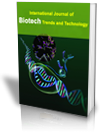Influence of Biofertilizers on In-Vitro Raised Plantlets of Santalum album(Linn.) for Better Growth and Survival under Nursery Conditions
Citation
MLA Style:Sushant Arade, Almas Khannam, T. S. Rathore "Influence of Biofertilizers on In-Vitro Raised Plantlets of Santalum album(Linn.) for Better Growth and Survival under Nursery Conditions" International Journal of Biotech Trends and Technology 10.1 (2020): 10-14.
APA Style:Sushant Arade, Almas Khannam, T. S. Rathore(2020). Influence of Biofertilizers on In-Vitro Raised Plantlets of Santalum album(Linn.) for Better Growth and Survival under Nursery Conditions. International Journal of Biotech Trends and Technology, 10(1), 10-14.
Abstract
A novel approach was undertaken to assess the growth performance and survival of in vitro raised Santalum album plantlets under nursery conditions in response to various biofertilizer applications. Due to parasitic nature, S. album finds it difficult to absorb a sufficient amount of moisture and essential nutrients directly from the soil on its own. Furthermore, plantlets raised through in vitro conditions often face a hard time to survive in the initial stages of hardening in the nursery. To overcome this problem, experiments were conducted to stimulate the uptake of water and nutrients by adding biofertilizers directly into the media (sand: soil: compost at 3:3:1 ratio) during secondary hardening. In the present study it was observed that among all treatments, a combination of Azotobacter and Pseudomonas (T7) reflected maximum height, collar diameter and the number of leaves per plant with a maximum percentage of survival. Therefore, the application of biofertilizers revealed a positive effect on the growth and survival of the overall plantlets of S. album.
References
[1] H.S. Ananthpadmanabha , H.C. Nagveni, and S.N. Rai. Influence of host plants on growth of sandal. My Forest,1988, 26 (2): 156-160.
[2] D. Annapurna,T.S. Rathore and G. Joshi. Modern nursery practices in the production of quality seedlings of Indian sandalwood (Santalum album L.) - Stage of host requirement and screening of primary host species. J. Sustain. For., 2006, 22(3&4): 33–55.
[3] D.J. Donnelly and W.E.Vidaver. Leaf anatomy of red raspberry transferred from culture to soil. J. Am. Soc. Hortic. Sci. 1984, 109: 172–176.
[4] A. Balasubramanian and A. Srinivasan.Response of certain tree species to vesicular arbuscular mycorrhizae inoculation. In: Mycorrhizae: Bio-fertilizers for the future, Adholeya, A and Singh, S. (eds.) Proc. Third Natl. Conf. on Mycorrhizae, 13-15 March, 1995, TERI, New Delhi, India, 550 pp.
[5] N.K. Binu, P.K. Ashokan andM. Balasundaran. Influence of different arbuscular mycorrhizal (AM) fungi and shade on the growth of sandal (Santalum album Linn.) seedlings. Journal of Tropical Forest Science,2015, 27: 158–165.
[6] J. Chen.The combined use of chemical and organic fertilizers and/or biofertilizer for crop growth and soil fertility 20. In: International Workshop on Sustained Management of the Soil-Rhizosphere System for Efficient Crop Production and Fertilizer Use, vol. 16. Land Development Department, Bangkok, Thailand. 2006.
[7] L. Nain, A. Rana, M. Joshi, S. D. Jadhav, D. Kumar and Y. S. Shivay. Evaluation of synergistic effects of bacterial and cyanobacterial strains as biofertilizers for wheat. Plant Soil, 2010, 331: 217– 230.
[8] T. Muthukumar andK. Udaiyan. Growth response and nutrient utilization of Casuarina equisetifolia seedlings inoculated with bioinoculants under tropical nursery conditions. New For.,2010, 40(1):101–118
[9] H.C. Nagaveni, G. Vijayalakshmi, D. Annapurna andH.S. Ananthapadmanabha. Association of sandal with vesicular arbuscular mycorrhiza (VAM) fungi. Pp 135–146 in Radomiljac AM et al. (eds) Sandal and its Products AICAR: Proceedings—Series 1998, No.84. 18–19 December 1997, Malleswaram.
[10] H.C. Nagaveni. Role of biofertilizers on growth of sandal plants. Book chapter Microbes and Sustainable Plant Productivity,2014, 6:65-69.
[11] Naresh Kumar, Anil Kumar, Ashok Shukla, Asha Ram, Ram Bahadur and O.P. Chaturvedi. Effect of Application of Bio-Inoculants on Growth and Yield of Arachis hypogaea L. and Sesamum indicum L. Int.J.Curr.Microbiol.App.Sci.2018, 7(1): 2869-2875.
[12] K. Parthasarathi, S.K. Gupta and P.S. Rao. Differential response in the cation exchange capacity of the host plants on parasitisation by sandal (Santalum album L.). Current Science,1974, 43: 20.
[13] A. Rashmi and D. Bhavana. Role of VAM in the development of agroforestry model and other floristic vegetation in the degraded land. Journal of Biodiversity and Environmental Sciences,2015, 7(4):1-8.
[14] Y.V. Sreenivasa Rao. Contributions to the physiology of sandal (Santalum album L.). Journal of the Indian Institute of Science,1933, 16A: 167-184.
[15] N.S. Subbarao, D. Yadav, H.S. Ananthapadmanabha, H.S. Nagaveni, C.S. Singh, and N.S. Kavimandan,. Nodule haustoria microbial features of Cajanus and Pongamia parasitised by sandal. Plant and Soil,1990, 128: 249-256.
[16] H.S. Thappar, A.K. Vijayan andK. Uriyal. Vesicular arbuscular mycorrhizal association and roots colonisation in some important tree species. Indian Forester,1992, 118: 207–212.
[17] R.K. Verma, A.K. Thakur and P.S. Rajput. Effect of organic amendments and plant growth promoting microbes on growth of sandal in Central India. Indian Forester, 2012, 138(8): 742-746.
[18] L. Wanntorp andR.L.P. De Craene. Perianth evolution in the sandalwood order Santalales. American Journal of Botany,2009, 96: 1361–1371.
Keywords
Biofertilizers, Santalum album, micropropagation, nursery conditions


